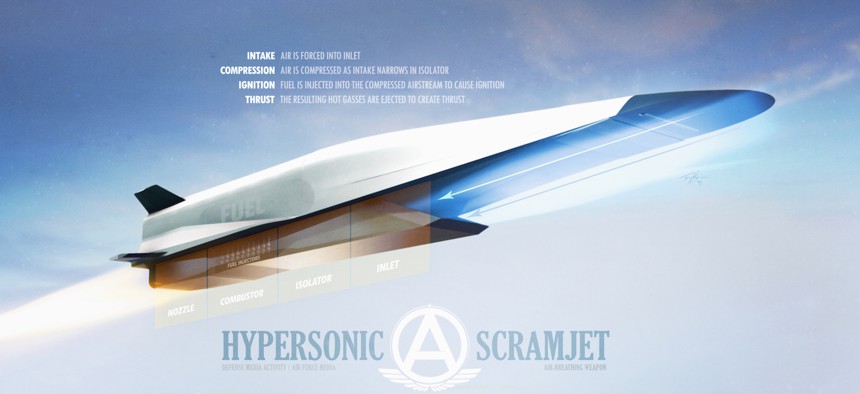
3D Illustration visualizing how the Scramjet hypersonic weapon creates thrust. U.S. Air Force / Travis Burcham
Plasma breakthrough could enable better hypersonic weapons, spacecraft
Hot electronics are a big problem for next-generation missiles. The fourth state of matter could be the solution.
A potential new way to protect sensitive electronics from the extreme heat generated by flying at high speed could give the United States an edge in the race to deploy hypersonic missiles and new spacecraft.
A July research paper in the American Chemical Society’s journal ACS Nano describes one potential solution that uses focused plasma, the photons and highly charged particles that make up the so-called fourth state of matter. If the method bears out in further research, it could usher in hypersonic weapons with much more advanced electronic guidance and could even enable on-the-ground weapons to evade heat sensors.
The breakthrough grew out of efforts to use a laser to measure the temperature of electronics in plasma-facing environments, work the Air Force is supporting through a grant at the University of Virginia, said professor Patrick Hopkins, one of the researchers on the paper.
“What we started to develop was a laser to probe the temperature of the sample surface within a microsecond resolution…And we could see that while the plasma was hitting the surface, we could measure how the temperature of the surface changed” Hopkins said in an interview. “We started to see something that didn't make sense at first, while we were developing this laser probe: we were seeing the surface was cooling first, then it would heat back up from the rest of the energetic species from the plasma.”
The reason for the temperature drop is the same reason focused plasma can be used to clean electronics.
“When you expose the surface of the material to a plasma, it can remove atoms from the sample surface. Effectively it can be conceptualized as evaporation of the material from the surface,” Hopkins said.
The effect is akin to the way sweat evaporating off our skin reduces our body temperature.
Hopkins said he has Air Force support to continue to investigate the phenomenon, which could have big consequences for the future of hypersonic missiles, space craft, or other vehicles where high heat could hurt electronics. Additionally, Hopkins’ start up company, Laser Thermal, is working on commercializing this laser-based temperature measurement through a Small Business Innovation Research program grant through the Air Force.
“If you want to cool something, the traditional way to cool it is you have a big massive heatsink or you have some refrigeration cycle with liquid and coolant. That's really heavy. That's going to weigh down your vehicle. What this enables is: through a plasma, there could be novel, lightweight ways that you could have a directed cooling solution that could now help to cool electronics on airplanes, on satellites, on hypersonic vehicles, that would not compromise size, weight and power.”
That’s of particular importance to the United States, which, unlike China and Russia, isn’t developing nuclear-armed hypersonic weapons, meaning that the weapons it does create will need to be much more precise and thus carry more advanced electronics aboard, as a February CRS report to Congress indicates.
If the plasma cooling effect can be reproduced and converted in new electronics cooling solution it could also help to cloak the thermal signature of some power-hungry electronic systems, like radars or high-powered radio devices.
“We don't have the picture completely figured out. This is an ongoing program. I don't want to claim that I know everything that is happening during this process, but we are studying that in detail,” he said.


